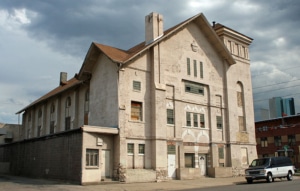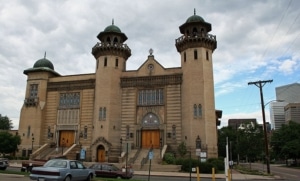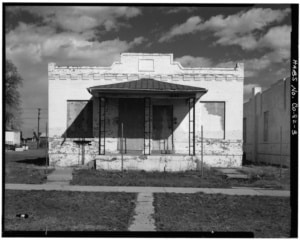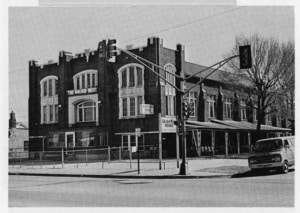DCPA NEWS CENTER
Enjoy the best stories and perspectives from the theatre world today.
Enjoy the best stories and perspectives from the theatre world today.
As Funny Girl takes audiences back into the life of Fanny Brice, the groundbreaking Jewish comedian of the early 20th century, fans can explore Jewish history closer to home, with a self-guided tour of Colorado’s own Jewish community.

Temple Emanuel, Curtis Street
TEMPLE EMANUEL
The oldest and largest synagogue between Kansas City and the West Coast, Temple Emanuel began as a Jewish burial and prayer society in 1866, when Colorado was still a territory. In 1875, it dedicated its first building at the corner of 19th and Curtis. A larger building, erected in 1892 at 24th and Curtis, is still standing and now houses several small businesses. In 1899, the congregation followed its members, who were moving to the East Side, and built a grand, Moorish-style temple at 1595 N. Pearl St., which is today the home of Denver Community Church. Today, Temple Emanuel is located in Hilltop, where it moved in 1957 to 51 Grape St.
NATIONAL JEWISH HEALTH
Perhaps you’ve noticed the sign over the stately Spanish Colonial building at the corner of 14th and Colorado that states, “None may enter who can pay – none can pay who enter.” This was the philosophy of the tuberculosis sanatorium that originally opened on the West Side, where Denver’s Jewish community began. Founded as the National Jewish Hospital for Consumptives in 1899, it served Jews and non-Jews without charge as thousands flocked to Denver to take “the cure” in the clean, cool mountain air. Today, National Jewish Health has expanded its mission and is generally ranked the premier hospital in the country for all respiratory issues.

Temple Emanuel, Pearl Street
LAKE STEAM BATHS
Fleeing persecution in Russia, immigrants Ethyl and Harry Hyman opened their traditional Russian bathhouse in 1927 at 3540 W. Colfax where it still stands today. In keeping with tradition, the bath house offers men-only and women-only hours and includes both hot baths and cold plunges.
YESHIVAS TORA CHAIM
Founded in 1967, this yeshiva brings together Jewish young men to learn in the Litvak (Lithuanian) style of Orthodox Judaism, studying Talmud in the traditional way. Located at 1555 Stuart St., it was described at its founding as the only yeshiva between Chicago and the West Coast.

Golda Meir House
GOLDA MEIR HOUSE
Golda Meir, prime minister of Israel from 1969 to 1974, was the third female head of state in the world. At the age of 8, she immigrated from Russia to Milwaukee with her family, but left Milwaukee for Denver in the hope of avoiding an arranged marriage and continuing her education. Then known as Golda Mabovitch, in 1913 she moved into the Julian Street home of her sister, Sheyna Korngold, and Sheyna’s husband. During the day, Golda studied at North High School, and the evenings were filled with intellectual and political discussions in her sister’s small living room. In her autobiography, she wrote, “to the extent that my own future convictions were shaped and given form…those talk-filled nights in Denver played a considerable role.” Meir also met her future husband in Denver. In 1988, on the verge of being demolished, the house was moved to its present home at 1148 9th St. on the Auraria Campus. Today, it operates as the Golda Meir House Museum and offers tours and education.
HEBREW EDUCATIONAL ALLIANCE
What is today Denver’s largest Conservative Jewish congregation formed in 1928 through the merger of the Denver Hebrew Institute and Beth David sisterhood. Its first building opened four years later at the corner of Meade and Colfax. The building later was operated by the Golden West Nursing Home and still stands today, while the congregation has moved to Southeast Denver.
BEYOND DENVER

Hebrew Education Alliance. Photo by Charles McNamara
In tiny Trinidad stands the National Historic Landmark of Temple Aaron, built in 1889. Although few Jews remain in the town today, its first mayor, Sam Jaffa, was Jewish, and the temple itself continues to operate, although its last full-time rabbi left in 1916.
Cotopaxi, on the banks of the Arkansas River, was formed in 1882 when 63 Russian Jews were enticed to move to southern Colorado with the promise of founding an agricultural community. They were promised homes and land but arrived to find that almost no homes had been built and lived through the first winter in canvas tents. Crops failed and the community disbanded in the summer of 1884. Today, a small Jewish section of the town cemetery honors those early settlers.
One of the best Jewish history sites in the state resides at 10,000 feet in Leadville. Temple Israel was a Reform temple dedicated in 1884, with May Company founder David May among its members. Since 2006, the restored building has served as an artifact-filled museum telling the story of the Jewish pioneers of Leadville.
